The Truth About Soreness
Let’s talk about something we’ve all felt and dreaded at some point – that next-day soreness after a training session that can make sitting down or walking up stairs feel like a workout in itself.

On the other hand, there are some who love to chase the soreness, believing it’s the best sign of a good workout. But that’s not exactly correct line-of-thinking either.
We covered finding the right intensity in your workouts in our last post, so now is the perfect time to clear up a big misconception…
🔸Soreness doesn’t always mean you had a great workout, and no soreness doesn’t mean you didn’t.
Clear as mud, eh?
So What Causes Soreness?
The soreness you feel after a workout is called DOMS – Delayed Onset Muscle Soreness. It usually kicks in 1-2 days after a workout, especially if:
◦ You’re a beginner or trying a new movement
◦ You’re experienced but trained a muscle group that hasn’t been challenged in a while
◦ You increased your weights or reps
◦ You emphasized the eccentric – lowering & muscle lengthening phase – of an exercise
◦ You did more volume or intensity than usual
This soreness is essentially microscopic damage in your muscles. That’s not a bad thing – it’s part of how we adapt and get stronger – but more damage isn’t always better.
What Soreness Doesn’t Tell You
Soreness is a sign your body did something different or unfamiliar. It’s not the gold standard for progress. In fact, if you’re always sore, it could mean:
◦ You’re not recovering well
◦ You’re doing too much too soon
◦ You’re not fueling or sleeping enough
◦ Your training lacks consistency
Progress comes from stimulus, recovery, and adaptation, not just feeling beat up all the time.
What Should You Aim For?
Instead of chasing soreness, aim for:
✅ A consistent routine (2–4x/week is magic for most of us)
✅ Smart progression – not doing too much, too fast
✅ Good form, solid effort, and appropriate rest
✅ Workouts that challenge you but don’t wreck you
When your body starts adapting to a well-structured program, you might actually feel less sore, and that’s a good thing. It means you’re getting stronger, more resilient, and more capable.
The real signs you’re on track:
✅ You’re showing up regularly
✅ You’re getting stronger
✅ You’re recovering well
✅ You feel good most of the time
What to Do If You Are Sore
A little soreness is totally normal, especially when switching things up. If you’re feeling it,
◦ Keep moving: light walking or an easy workout can help
◦ Hydrate and fuel well
◦ Stretch and foam roll if it feels good
◦ Sleep! That’s when the magic happens!
Remember, soreness is a signal, not a scoreboard. Progress comes from consistency at the right intensity, not from punishing yourself.
You don’t have to be sore to be successful. You do have to show up, train smart at an appropriate intensity, and stay consistent.
See you at the gym! 💪
~ Coach MJ 😉

